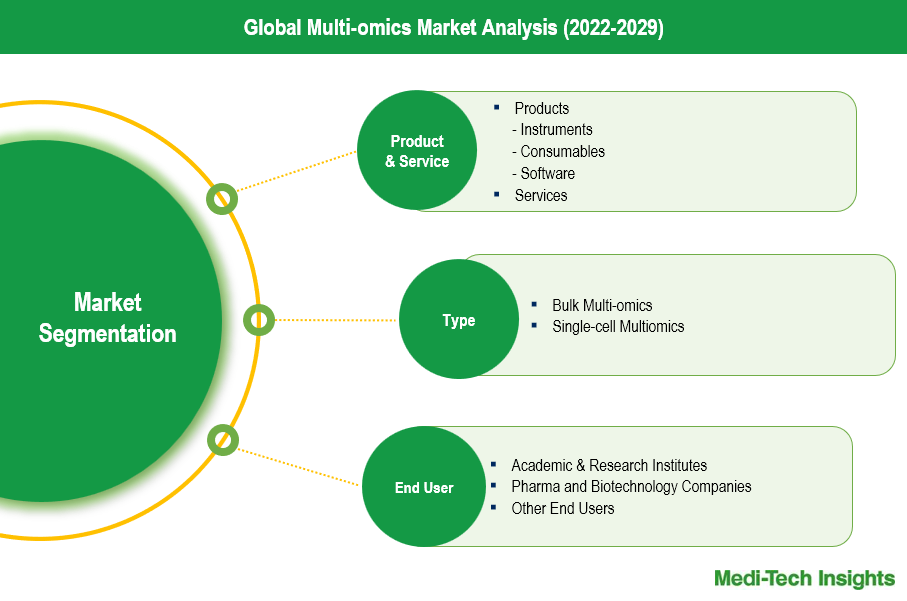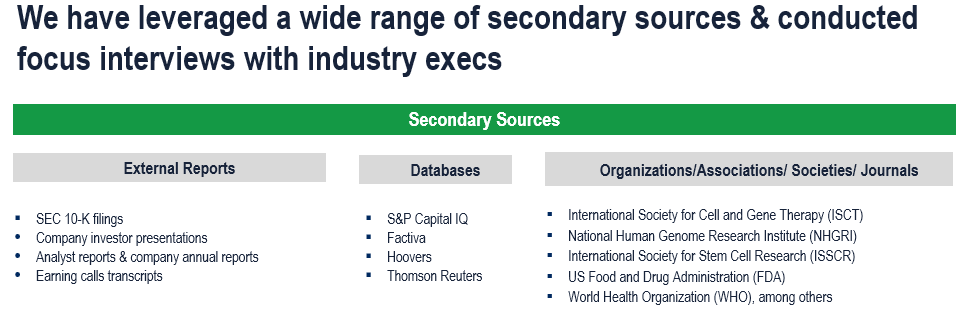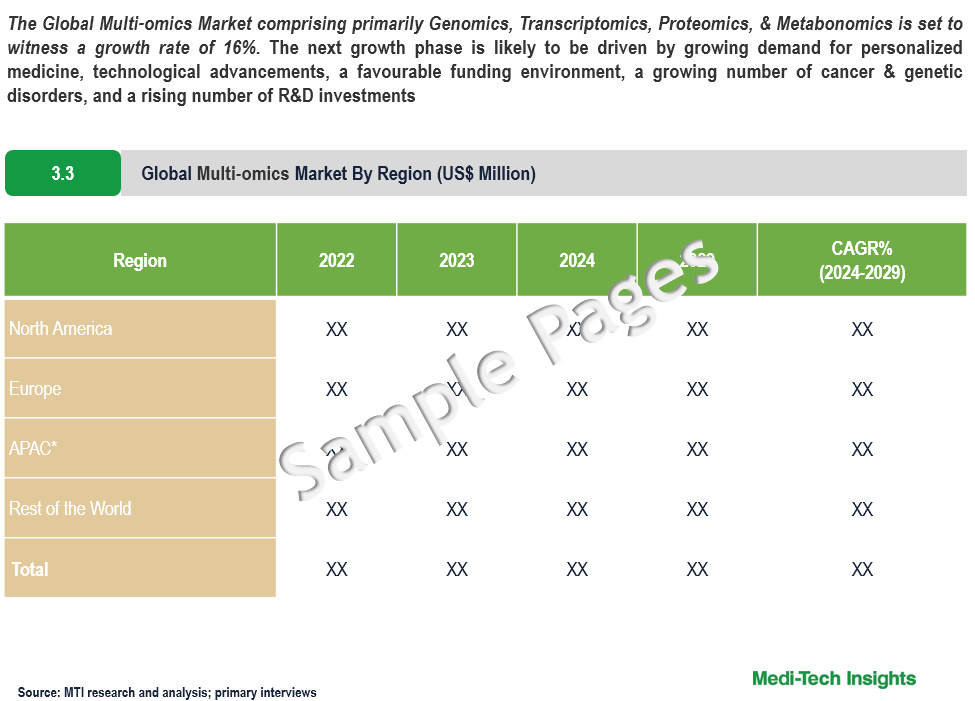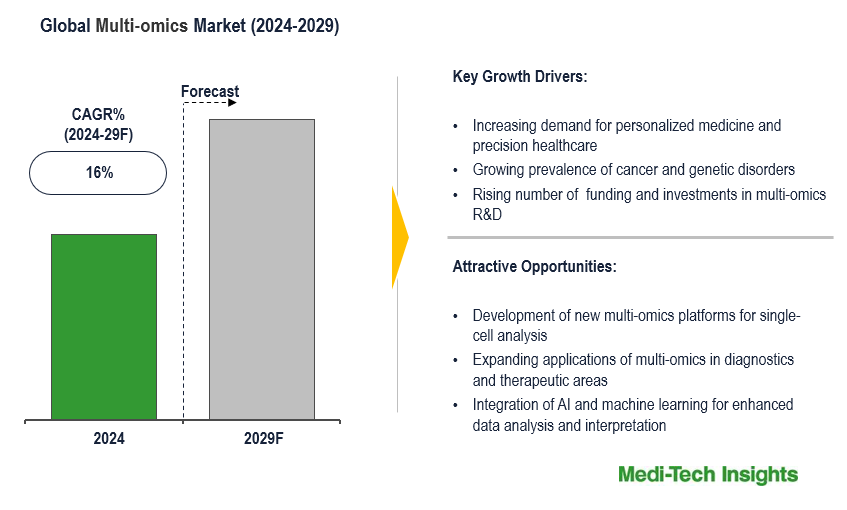
Multi-omics Market Size, Trends, Growth, Industry Share, and Analysis for Forecasts 2024 to 2029
The Global Multi-omics Market comprising primarily Genomics, Transcriptomics, Proteomics, & Metabonomics is set to witness a growth rate of 16%. The next growth phase is likely to be driven by growing demand for personalized medicine, technological advancements, a favourable funding environment, a growing number of cancer & genetic disorders, and a rising number of R&D investments. To learn more about the research report, download a sample report.
Omics has turned out to be a new mantra in molecular research. It is the field of study in biological sciences that ends in the suffix – omics. Many areas of research can be classified as omics such as genomics, transcriptomics, proteomics and metabolomics.
- Genomics studies genes and their function. Genomics finds application in drug discovery and development, diagnostics & therapeutic decision-making, agriculture, animal research and other applications
- Transcriptomics studies mRNAs. It is widely used for clinical diagnostics, drug discovery, toxicogenomic and other applications
- Proteomics studies proteins. It is used for clinical diagnosis of cancer, infectious diseases, cardiovascular diseases, immune diseases, neurological disorders, diabetes, etc. and drug discovery.
- Metabonomics studies small molecules involved in cellular metabolism. It is a powerful research tool that is currently being applied to various aspects of drug and biomarker discovery, toxicology research, nutrigenomics and other applications
A complete understanding of human health and diseases warrants interpretation of molecular intricacy and variations at multiple levels such as genome, transcriptome, proteome, and metabolome. With the advent of sequencing technology, biology has become increasingly reliant on data generated at these levels, which collectively is called “multi-omics” data. The availability of multi-omics data has revolutionized the field of medicine and biology. Data integration across different platforms (genomics, transcriptomics, proteomics and metabolomics) helps in understanding causal relationships across multiple levels of cellular organization. It offers unparalleled opportunities to understand the underlying biology of complex diseases such as cancer.
“The advent of Multi-omics is turning scientists into molecular detectives and helping them to delve into the depths of disease. It allows researchers and scientists to probe the more complex and transient molecular changes that underpin the course of disease and responses to treatment, helping them better select the right drug target.”
- Senior Director, Data Sciences & Quantitative Biology, Tier I Pharmaceutical & Biotechnology Company
To learn more about this report, download the PDF brochure
Single-cell Analysis Enters the Multi-Omics Era
A cell's condition can be defined by the interplay between its genome, epigenome, transcriptome, and proteome. Riding on the development of these omics technologies, multi-omics technologies for single cells have emerged that can capture multiple omic layers from the same cell. Profiling multiple omic layers makes it possible to capture a more complete set of information about each cell than is possible from any single omic layer alone. Single-cell multi-omics better reflects the complex network of interactions responsible for cellular functions and hence are considered more powerful than stand-alone omics. Single-cell multi-omics technologies are set to take centre stage in biomedical research as they characterise cells and tissues at an unparalleled molecular and architectural resolution. For instance,
- In June 2024, Bio-Rad Laboratories, Inc. announced the launch of the ddSEQ™ Single-Cell 3' RNA-Seq Kit and the complementary Omnition v1.1 analysis software for single-cell transcriptome and gene expression research
- In November 2023, OWKIN and 10x Genomics, Inc. announced an agreement to incorporate 10x Genomics' spatial omics and single-cell technologies into the MOSAIC project, which is renowned for its innovative tumour analysis for therapeutic discovery
Key Challenges / Restraints
The multi-omics market faces significant hurdles, including complex workflows and a lack of standardization, which hinder data integration and reproducibility. Additionally, high costs, lack of skilled labour, and ethical and regulatory concerns regarding data privacy and informed consent further constrain market growth.
Regional Growth Dynamics in the Multi-omics Market: North America's Lead and Asia-Pacific's Rapid Expansion
The multi-omics market exhibits varied growth patterns across different regions. North America is expected to maintain the largest market share due to the strong presence of leading companies and substantial investments in multi-omics research and technology. Europe also represents a significant portion of the market, driven by advancements in genomics and other omics technologies, along with substantial research funding and government support. Countries like Germany, France, and the UK are at the forefront of this growth.
The Asia-Pacific region is anticipated to experience the fastest growth. Factors such as the increasing prevalence of chronic diseases, rising investments in research and development, and technological advancements are driving this expansion. Countries like China, Japan, and India are leading this growth, leveraging multi-omics for precision medicine and personalized healthcare solutions.

To learn more about this report, download the PDF brochure
Growth Insights for the Multi-omics Market: Products and Services Segment
In the multi-omics market, the product segment dominates revenue due to the continuous advancements in instruments, consumables, and software that are crucial for detailed multi-omics research. These products enable comprehensive analyses across genomics, transcriptomics, proteomics, and metabolomics. The service segment is also growing fast, driven by the rising demand for specialized support in managing complex multi-omics workflows and ensuring precise, reproducible results. Together, innovative products and essential services are driving significant advancements and broader applications in the multi-omics field.
Understanding the Dynamics of Multi-Omics Market: Bulk and Single-Cell Analysis
The multi-omics market by type is divided into two primary segments: bulk and single-cell multi-omics, each playing pivotal roles in advancing biological understanding and therapeutic development. Bulk analysis involves extracting and analyzing genetic material from a population of cells, offering insights into average gene expression levels and genetic variations across a sample. This method dominates the current multi-omics landscape due to its established protocols and broader applicability in studying complex diseases and biological processes. However, single-cell analysis has gained significant traction for its ability to dissect cellular heterogeneity by profiling individual cells, providing precise insights into cell-to-cell variability and rare cell populations. Single-cell technologies are rapidly expanding, driven by advancements in sequencing and bioinformatics, catering to the growing demand for personalized medicine and detailed biological understanding.
Competitive Landscape Analysis
Some of the key players operating in the market are 10x Genomics, Bio-Techne Corporation, Fluidigm Corporation (Standard Bio Tools), Bio-Rad Laboratories, Inc., NanoString, Mission Bio, BD Biosciences, Thermo Fisher Scientific Inc., among others.
Emerging Players Developing Multi-omics Solutions
- AgenT S.A.S.
- OmniTier Inc.
- Mitra Bio
- Proteona (Acquired by Singleron)
- BioTuring
- Govita Tech Limited
- Scipio Bioscience, among others

Get a sample report for competitive landscape analysis
Organic and Inorganic Growth Strategies Adopted by the Leading Market Players to Establish Their Foothold in the Global Multi-omics Market
Leading players operating in the global market are adopting both organic and inorganic growth strategies such as launching new services, acquiring related firms, and entering into collaborations to garner a higher market share.
- In March 2024, Beckman Coulter Life Sciences which is a part of Danaher Corporation announced the launch of the CytoFLEX Flow Cytometer, a purpose-built nanoscale flow cytometer for research use only that enables detection to at least 40 nm, enabling 30-50% more data creation
- In December 2023, 10x Genomics, Inc. announced a collaboration with the NIH Intramural Center for Alzheimer's and Related Dementias (NIH CARD) to use Chromium Single Cell Multiome technology to create a comprehensive single-cell atlas of the human brain by profiling the epigenome and whole transcriptome across millions of individual cells from diverse brain samples, advancing neuroscience research
- In November 2023, Illumina Inc. announced the new TruSight™ Oncology 500 ctDNA v2, a distributed liquid biopsy assay for comprehensive genomic profiling of circulating tumour DNA from blood, designed for non-invasive analysis when tissue testing is unavailable or to complement tissue-based testing
- In September 2023, at the 22nd Human Proteome Organization World Congress, Bruker Corporation announced new advancements in instrumental methods, consumables, and software for 4D-Proteomics, MALDI HiPLEX-IHC spatial tissue proteomics, 4D-Lipidomics, and 4D-Metabolomics
- In May 2021, Caris Life Sciences raised $830 million to expand its precision medicine platform
- In June 2021, Element Biosciences secured $276 million to support the commercial launch of a disruptive next-generation DNA sequencing platform
The Global Multi-omics Market is expected to gain further momentum in the upcoming years due to the growing demand for personalised medicine and precision healthcare, the rising number of investments in multi-omics research, technological advancements, stringent regulatory policies and aggressive organic and inorganic growth strategies followed by the key market players.
Multi-omics Market Scope
| Report Scope | Details |
| Base Year Considered | 2023 |
| Historical Data | 2022 - 2023 |
| Forecast Period | 2024 - 2029 |
| CAGR (2024-2029) | 16% |
| Segment Scope | Product and Service, Type, Platform, Application and End User |
| Regional Scope |
|
| Key Companies Mapped | 10x Genomics, Bio-Techne Corporation, Fluidigm Corporation (Standard Bio Tools), Bio-Rad Laboratories, Inc., NanoString, Mission Bio, BD Biosciences, Thermo Fisher Scientific Inc., among others |
| Report Highlights | Market Size & Forecast, Growth Drivers & Restraints, Trends, Competitive Analysis |
Key Strategic Questions Addressed
-
What is the market size & forecast for the Global Multi-omics Market?
-
What are the historical, present, and forecasted market shares and growth rates of various segments and sub-segments of the Global Multi-omics Market?
-
How has COVID-19 impacted the Global Multi-omics Market?
-
What are the major growth drivers, restraints/challenges impacting the market?
-
What are the opportunities prevailing in the market?
-
What is the investment landscape?
-
Which region has the highest share in the global market? Which region is expected to witness the highest growth rate in the next 5 years?
-
Who are the major players operating in the market? What is the competitive positioning of key players?
-
Who are the new players entering the market?
-
What are the key strategies adopted by players?
- Research Methodology
- Secondary Research
- Primary Research
- Market Estimation
- Market Forecasting
- Executive Summary
- Market Overview
-
- Market Dynamics
- Drivers
- Restraints
- Key Market Trends
- Industry Speaks
- Market Dynamics
- Key Revenue Pockets
- Global Multi-omics Market - Size & Forecast (2021-2028), By Product and Service
- Products
- Instruments
- Consumables
- Software
- Services
- Products
- Global Multi-omics Market - Size & Forecast (2021-2028), By Type
- Bulk Multi-omics
- Single Cell Multi-omics
- Global Multi-omics Market - Size & Forecast (2021-2028), By Platform
- Genomics
- Transcriptomics
- Proteomics
- Metabolomics
- Integrated Omics Platforms
- Global Multi-omics Market - Size & Forecast (2021-2028), By Application
- Cell Biology
- Oncology
- Neurology
- Immunology
- Global Multi-omics Market - Size & Forecast (2021-2028), By End User
- Academic & Research Institutes
- Pharmaceutical and Biotechnology Companies
- Other End Users
- Global Multi-omics Market - Size & Forecast (2021-2028), By Region
- North America (U.S. & Canada)
- Europe (UK, Germany, France, Italy, Spain, Rest of Europe)
- Asia Pacific (China, India, Japan, Rest of Asia Pacific)
- Rest of the World (Latin America, Middle East & Africa)
- Competitive Landscape
- Key Players and their Competitive Positioning
- Competitive Positioning of Key Players (2022)
- Offerings Assessment, By Player
- Key Strategies Assessment, By Player (2021-2023)
- New Product & Service Launches
- Partnerships, Agreements, & Collaborations
- Mergers & Acquisitions
- Geographic Expansion
- Key Players and their Competitive Positioning
- Key Companies Scanned (Indicative List)
- 10x Genomics
- Bio-Techne Corporation
- Fluidigm Corporation (Standard Bio Tools)
- Bio-Rad Laboratories, Inc.
- NanoString, Mission
- Bio, BD Biosciences
- Thermo Fisher Scientific Inc
- AgenT S.A.S.
- OmniTier Inc.
- Mitra Bio
- Proteona (Acquired by Singleron)
- BioTuring
- Govita Tech Limited
- Scipio Bioscience
- Other Prominent Players
The study has been compiled based on extensive primary and secondary research.
Secondary Research (Indicative List)

Primary Research
To validate research findings (market size & forecasts, market segmentation, market dynamics, competitive landscape, key industry trends, etc.), extensive primary interviews were conducted with both supply and demand-side stakeholders.
Supply Side Stakeholders:
- Senior Management Level: CEOs, Presidents, Vice-Presidents, Directors, Chief Technology Officers, Chief Commercial Officers
- Mid-Management Level: Product Managers, Sales Managers, Brand Managers, Business Development Managers, Consultants
Demand Side Stakeholders:
- Stakeholders in Academics and Research Institutes, Pharmaceutical & Biotechnology Companies, and Other End Users
Breakdown of Primary Interviews

Market Size Estimation
Both ‘Top-Down and Bottom-Up Approaches’ were used to derive market size estimates and forecasts.
Data Triangulation
Research findings derived through secondary sources & internal analysis were validated with Primary Interviews, Internal Knowledge Repository, and Company Sales Data.




